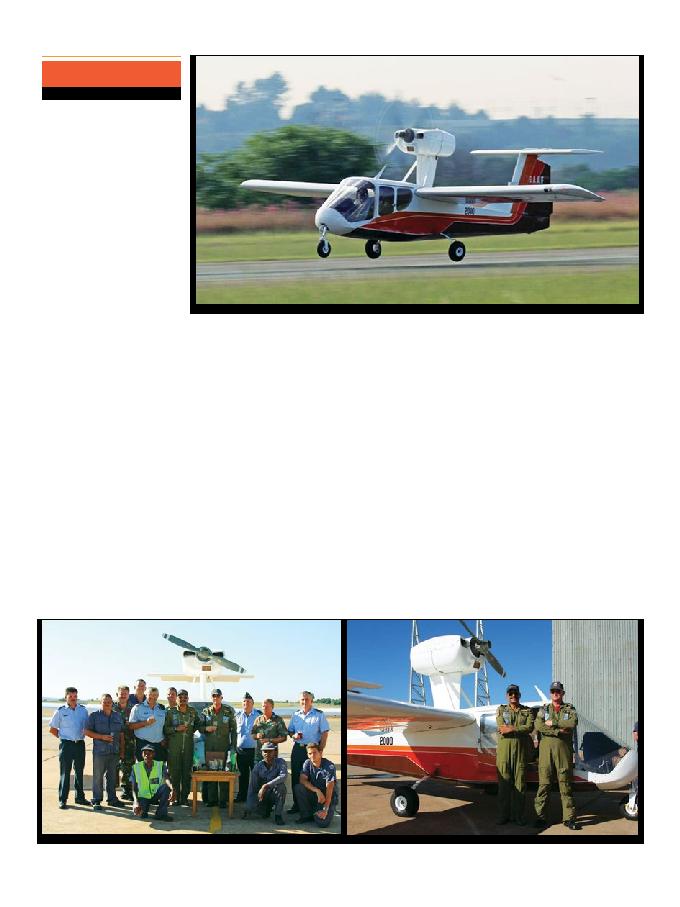
34
GA
/ Vol. 5 / No.4 / APRIL 2013
By Garth Calitz
Restoration News
Early Thursday morning on the 7th
February 2013 the Patchen Explorer
TSC-2 was pushed out of Hangar
14 ready to make its first flight in 13
years, Lt Gen. Des Baker and Col.
Rama Iyer ran through the pre-flight
inspection amid an atmosphere of
electric anticipation. WO1 "Toitjie"
du Toit and his team have spent many
man hours restoring this little aircraft
to the point that it was ready to be
handed to the pilots for the first of
many test flights. The aircraft was
last flown by Maj James "Jimmy Jet"
Feuilherade on the 2nd March 2001.
The Patchen Explorer, the
Brainchild of David Thurston of
Thurston Aircraft Corporation in
the USA, is powered by a Single
Lycoming 200hp motor with a
variable pitch propeller mounted
above the wing on a pylon. Aerofab
Corporation of Sanford, Maine, USA
constructed the prototype in 1972,
and it first flew on 13th October 1972
piloted by test pilot Win Young.
The Explorer never went into
production and only one was ever built.
It was designed as a land version of
the TSC-1 Teal amphibian, the project
was bankrolled by the late Marvin
Patchen, owner of Marvin Patchen
Incorporated. He envisioned it to be
a "cheaper, faster, more maintenance-
free alternative to the helicopter for
such tasks as pipeline and fire patrol,
fish spotting, aerial photography
platform and police missions." The
project was later acquired by Maitland
Reed's National Dynamics (Pty) Ltd
of Durban, based at Virginia Airport.
After successful test flights by test pilot
Pikkie Rautenbach in August 1975, Mr
Reed offered the aircraft to the SAAF
for evaluation with the aim of the
aircraft being produced for, and used
by, the SAAF as a spotter in the "Bush
War "but the SAAF decided on the
Aermacchi AM-3 "Bosbok" instead.
The Patchen was sent to TFDC
(Test Flight Development Centre) at
AFB Waterkloof where it was used as
a communications platform carrying
the serial number 2000. It made its
first flight as a SAAF aircraft on the
23rd September 1975 and at the time
the Patchen had a mere 206 flying
hours. Between 1976 and 1979 she
flew no more than 49 hours, of which
18 hours were spent flying the aircraft
to Rhodesia, now Zimbabwe, by
Capt Dean and Capt Rawston. It was
there evaluated by Peter J. H. Petter-
Bowyer of the Rhodesian Air Force.
The Patchen Explorer was reported
to have a very high CFG which had to
be well managed especially in gusty
winds. It was also noted the large
deflections of ailerons required large
stick inputs due to the "barn door"
design of the aircraft. With a very low
cabin seat position in the aircraft the
new pilots often flared out too high
on landing and ran out of airspeed
causing very hard landings. The nose
gear had to be repaired on more than
one occasion as it was prone to damage
in the case of such hard landings.
The SA Air Force decided it was
not viable to continually repair the
aircraft. The Patchen was subsequently
left in a hangar to deteriorate slowly
between 1979 and 1986. TFDC moved
from Waterkloof to Overberg at which
time it was decided to dispose of the
Aircraft. Fortunately the Museum staff
lobbied that they take possession of
the Patchen and relocate it to the South
African Air Force Museum which was
based at Lanseria Airport at the time.
The motivation behind this request was
that it was one of a kind and should be
preserved. The nose gear was repaired
and she was ferried across to Lanseria
in 1994. In the following years the
Patchen became a regular participant at
air shows across the country and was
flown as far afield as Margate, Port
Elizabeth and Cape Town. The aircraft
was now sporting a civilian registration
number ZS-UGF and quickly built
hours taking it up 440 hours.
After almost thirteen years the
Patchen Explorer has been resurrected,
thanks to the determination and drive
of the Director Flight Training, Col
Rama Iyer, Officer Commanding
SAAF Museum Lt Col Mike O'Connor
and the enthusiasm of the Museum
technical staff led by WO1 "Toitjie"
du Toit. On landing, all the flying and
technical crew celebrated with a glass
of champers and grape juice for those
on duty. The South African Air Force
Museum "200 Squadron" are very
proud to add yet another serviceable
aircraft to their impressive stable. ·
The SAAF Museum
Patchen Explorer
Flies again
The Patchen gets airborne from Swartkop AFB.
The team responsible for this successful project.
The Test pilots who undertook the first flight

